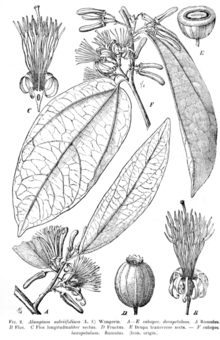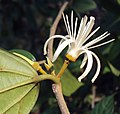
A pollinator is an animal that moves pollen from the male anther of a flower to the female stigma of a flower. This helps to bring about fertilization of the ovules in the flower by the male gametes from the pollen grains.

Sunbirds and spiderhunters make up the family Nectariniidae of passerine birds. They are small, slender passerines from the Old World, usually with downward-curved bills. Many are brightly coloured, often with iridescent feathers, particularly in the males. Many species also have especially long tail feathers. Their range extends through most of Africa to the Middle East, South Asia, South-east Asia and southern China, to Indonesia, New Guinea and northern Australia. Species diversity is highest in equatorial regions.

The purple sunbird is a small bird in the sunbird family found mainly in South and Southeast Asia but extending west into parts of the Arabian peninsula. Like other sunbirds they feed mainly on nectar, although they will also take insects, especially when feeding young. They have a fast and direct flight and can take nectar by hovering like a hummingbird but often perch at the base of flowers. The males can appear all black in harsh sunlight but the purple iridescence is visible on closer observation or under good light conditions. Females are olive above and yellowish below.

The purple-rumped sunbird is a sunbird endemic to the Indian Subcontinent. Like other sunbirds, they are small in size, feeding mainly on nectar but sometimes take insects, particularly when feeding young. They can hover for short durations but usually perch to suck nectar from flowers. They build a hanging pouch nest made up of cobwebs, lichens and plant material. Males are brightly coloured but females are olive above and yellow to buff below. Males are easily distinguished from the purple sunbird by the light coloured underside while females can be told apart by their whitish throats.

The crimson-backed sunbird or small sunbird is a sunbird endemic to the Western Ghats of India. Like other sunbirds, they feed mainly on nectar although they take insects, especially to feed their young. They are tiny birds that are resident and are found in forests but are particularly attracted to gardens at the edge of the forest where people grow suitable flower-bearing plants. They usually perch while taking nectar.

Cassia fistula, commonly known as golden shower, purging cassia, Indian laburnum, or pudding-pipe tree, is a flowering plant in the family Fabaceae. The species is native to the Indian subcontinent and adjacent regions of Southeast Asia, from southern Pakistan through India and Sri Lanka to Bangladesh, Myanmar and Thailand. It is a popular ornamental plant and is also used in herbal medicine.

The pale-billed flowerpecker or Tickell's flowerpecker is a tiny bird that feeds on nectar and berries, found in India, Sri Lanka, Bangladesh and western Myanmar. The bird is common especially in urban gardens with berry bearing trees. They have a rapid chipping call and the pinkish curved beak separates it from other species in the region.

Ornithophily or bird pollination is the pollination of flowering plants by birds. This sometimes coevolutionary association is derived from insect pollination (entomophily) and is particularly well developed in some parts of the world, especially in the tropics, Southern Africa, and on some island chains. The association involves several distinctive plant adaptations forming a "pollination syndrome". The plants typically have colourful, often red, flowers with long tubular structures holding ample nectar and orientations of the stamen and stigma that ensure contact with the pollinator. Birds involved in ornithophily tend to be specialist nectarivores with brushy tongues and long bills, that are either capable of hovering flight or light enough to perch on the flower structures.

Alangium is a small genus of flowering plants. The genus is included either in a broad view of the dogwood family Cornaceae, or as the sole member of its own family Alangiaceae. Alangium has about 40 species, but some of the species boundaries are not entirely clear. The type species for Alangium is Alangium decapetalum, which is now treated as a subspecies of Alangium salviifolium. All of the species are shrubs or small trees, except the liana Alangium kwangsiense. A. chinense, A. platanifolium, and A. salviifolium are known in cultivation.
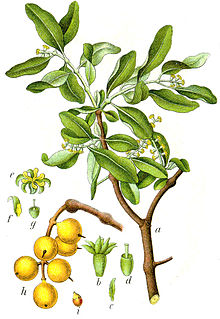
Loranthus is a genus of parasitic plants that grow on the branches of woody trees. It belongs to the family Loranthaceae, the showy mistletoe family. In most earlier systematic treatments it contains all mistletoe species with bisexual flowers, though some species have reversed to unisexual flowers. Other treatments restrict the genus to a few species. The systematic situation of Loranthus is not entirely clear.
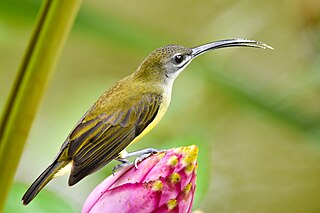
The little spiderhunter is a species of long-billed nectar-feeding bird in the family Nectariniidae found in the moist forests of South and Southeast Asia. Unlike typical sunbirds, males and females are very similar in plumage. They are usually seen in ones or twos and frequently make a tzeck call and are most often found near flowering plants, where they obtain nectar.

Vateria indica, the white dammar, is a species of tree in the family Dipterocarpaceae. It is endemic to the Western Ghats mountains in India. It is threatened by habitat loss. It is a large canopy or emergent tree frequent in tropical wet evergreen forests of the low and mid-elevations.

Xylocopa latipes, the tropical carpenter bee, is a species of carpenter bee widely dispersed throughout Southeast Asia. As its name suggests, this bee inhabits forests in warm tropical climates and constructs nests by burrowing into wood. It often makes long deep tunnels in wooden rafters, fallen trees, telephone poles and the like, but is not found in living trees.
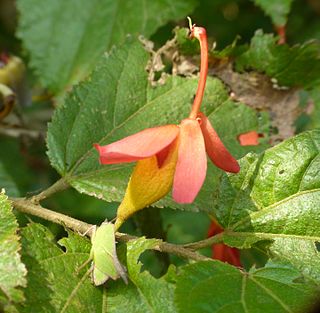
Helicteres isora, sometimes called the Indian screw tree, is a small tree or large shrub found in southern Asia and northern Oceania. It is usually assigned to the family Malvaceae, but it is sometimes assigned to the family Sterculiaceae. The red flowers are pollinated mainly by sunbirds, butterflies, and Hymenoptera. In the 19th century fibers from the bark were used to make rope and sacks, although nowadays the tree is harvested for the fruits and roots which are used in folk medicine.
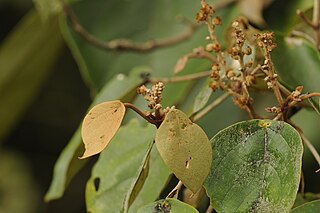
Mallotus tetracoccus, also known as the rusty kamala, is a species of flowering plant in the family Euphorbiaceae. It is a tree species found in parts of south Asia, typically occurring in the edges of tropical wet evergreen and semi-evergreen forests.
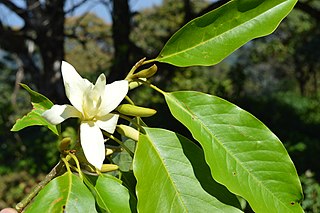
Magnolia nilagirica is a species of plant in the family Magnoliaceae. It is a tree that is threatened by habitat loss, endemic to the Western Ghats of India, and also Sri Lanka.

Xylocopa pubescens is a species of large carpenter bee. Females form nests by excavation with their mandibles, often in dead or soft wood. X. pubescens is commonly found in areas extending from India to Northeast and West Africa. It must reside in these warm climates because it requires a minimum ambient temperature of 18 degrees Celsius in order to forage.
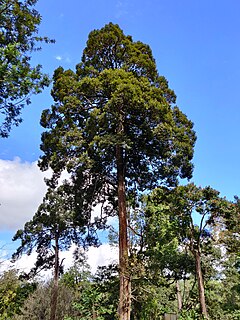
Cullenia exarillata is a flowering plant evergreen tree species in the family Malvaceae endemic to the rainforests of the southern Western Ghats in India. It is one of the characteristic trees of the mid-elevation tropical wet evergreen rainforests and an important food plant for the endemic primate, the lion-tailed macaque.

Hugonia mystax is a species of plant in the family Linaceae found mainly in the dry forests of peninsular India and Sri Lanka. It is a scandent shrub, sometimes growing liana-like over other trees and bears yellow flowers and orange to red fruits in the rainy season. The branchlets are leafless at the base and instead have a pair of recurved spines which bear a resemblance to a moustache, giving rise to the epithet mystax, Latin for moustache.

Baccaurea courtallensis is a flowering plant evergreen tree species belonging to the family Phyllanthaceae. It is endemic to the Western Ghats mountains in India. It is a medium size understory tree frequent in tropical wet evergreen forests of the low and mid-elevations (40-1000m). It is a Near Threatened species according to the IUCN Red List of Threatened Species.
